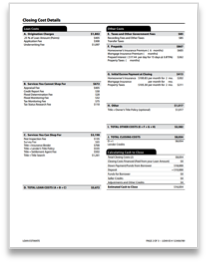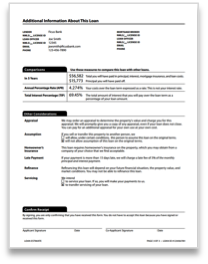CFPB RESPA/TILA Rule Reference: 5.6, Page 26-27, CFPB Detailed Summary of the Rule
As of August 2015, the Loan Estimate (LE) disclosure replaces the current GFE and the Initial TIL for most mortgage loans as a part of the CFPB’s initiative to increase consumer understanding and marketplace fairness.
Both the LE and the Closing Disclosure Form (CDF) detail the costs of a loan product and are designed to significantly resemble each other. This way, consumers can clearly see whether or to what extent their final costs rose or fell relative to their original estimate.
If you missed our previous posts, start at the beginning of this series with an overview of the development and purpose of the new Loan Estimate form.
The first page of the Loan Estimate disclosure includes general information about the loan, total costs, and monthly payment information.
The second page details line-items for all closing costs. This information is organized into four main categories:
· Loan Costsand Other Costs associated with the loan based on a good-faith estimate
· A Calculating Cash to Close table to show how the amount of cash needed at closing is calculated
· An Adjustable Payment (AP) table, if applicable for the loan product, that shows relevant information about how the monthly payments will change
· An Adjustable Interest Rage (AIR) table, if applicable for the loan product, which shows relevant information about how the interest rate will change
Most items associated with the mortgage are included in the first section, Loan Costs and Other Costs. Loan Costs are those paid by the consumer to the lender or paid to the third-party providers of services that the lender requires the consumer to obtain during the origination process. Other Costs include taxes, governmental recording fees, and other miscellaneous costs involved in the real estate closing process such as pre-paid homeowner’s insurance premiums. There are some additional rules about how these charges are described. For example, any items that are a component of title insurance must include the introductory description, “Title—.”
Loan Costs are broken down further into three subsections: “Origination Charges,” “Services You Cannot Shop For,” and “Services You Can Shop For.” These subsections implicitly suggest which charges are subject to which tolerances — that is, how much the final charge may legally rise over the original estimate before the lender is not allowed the collect the difference. There is very specific CFPB guidance about these tolerances which we’ll discuss in another series coming soon.
 The third and final page of the LE contains additional information about the loan including Contact Information, a Comparisons table, an Other Considerations table, and, if desired by the lender, a Signature Statement for the consumers to sign acknowledgment of receipt of the estimate.
The third and final page of the LE contains additional information about the loan including Contact Information, a Comparisons table, an Other Considerations table, and, if desired by the lender, a Signature Statement for the consumers to sign acknowledgment of receipt of the estimate.
The Comparisons table answers questions about the total amounts that would be paid in the first five years of the loan and the Total Interest Percentage (TIP) (that is, the total amount of interest that the consumer will pay over the loan term as a percentage of the loan amount) in addition to the APR.
The Other Considerations table includes general disclosure statements affecting the loan. The information may include, for example, penalties for late payments or information about who will service the loan. One way to reduce the vast stack of paperwork at the closing table is for lenders to place one-off disclosure statements in this section rather than to include an additional page for each. However, if state law requires any particular additional disclosures, they must be presented on a separate page and must not be a part of the Loan Estimate.
Generating new Loan Estimate forms in place of the GFE and initial TIL disclosure represents one of the greatest impacts of the CFPB’s new rules for mortgage loan products. In the long run, the market may benefit from the standardization of mortgage form but there will certainly be complications related to sourcing and analyzing data fast enough to generate accurate estimates and for delivering the forms on time. The stakes couldn’t be higher because the Loan Estimate will more or less bind lenders to its provisions should the consumer intend to proceed with originating the loan.
In order to manage this huge shift in loan application operations, lenders will need to have both a plan and the tools to get these documents out the door within three days and also to ensure that they’re at least as (if not more) accurate than the Good Faith Estimates being generated today.
We elaborate more on how this impacts business, and how technology solutions mitigate that impact, in the knowledge article titled “A look at the business impacts of the Loan Estimate form” in the TILA-RESPA Knowledge Center.
All information and views expressed or implied are provided without warranty and are only the opinion of Pavaso, Inc. Each participant should seek legal representation for legal interpretation of the ruling and the CFPB directly for final instruction and interpretation. The final rule can be found here.





